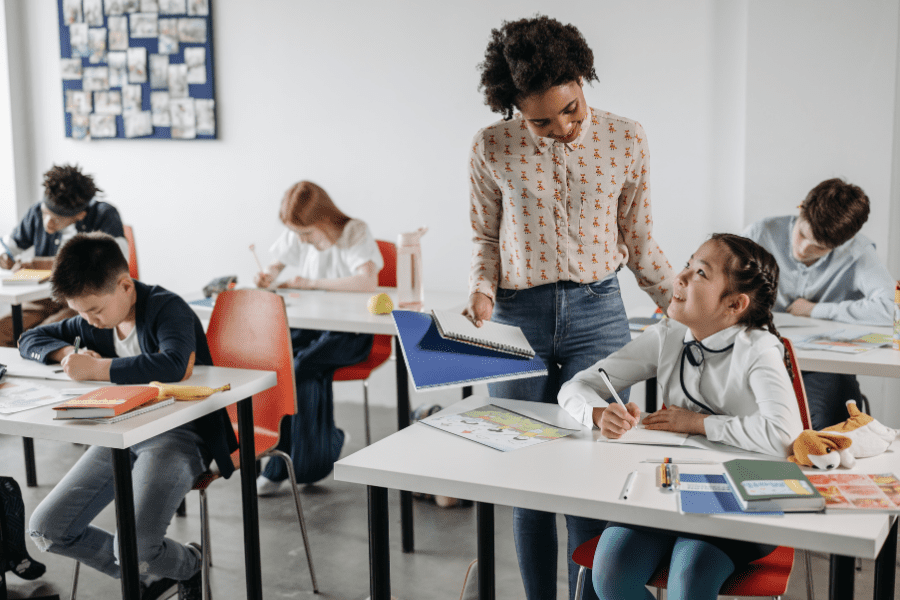
The POWER of Feedback
- Posted by ednnovate
- Categories Teacher Development
- Date September 12, 2023
Turning Good into Great!
The Research on Feedback
The Significance of Feedback on Educational Outcomes
John Hattie and Helen Timperley’s groundbreaking meta-analysis in the Review of Educational Research posits feedback as one of the most powerful influences on student learning and achievement (Hattie & Timperley, 2007). Their study synthesizes an extensive data set of research reports to examine the factors that impact educational outcomes, and their conclusion elevates the importance of feedback in teaching and learning. Notably, they highlight that the effectiveness of feedback can vary widely depending on its type, timing, and the context in which it is given.
Types of Feedback and Their Effectiveness
Hattie and Timperley categorize feedback into four main types: Task-level, Process-level, Self-regulation level, and Self-level feedback. Each type serves a different purpose and can have different effects on learning outcomes.
- Task-Level Feedback: This type of feedback focuses directly on the specific task or activity that the student is engaged in. It includes information about the correctness or quality of the work, such as pointing out errors, offering specific corrections, or highlighting what was done well. Task-level feedback is foundational as it directly addresses the academic content or skills being learned. For example, in a math problem, task-level feedback might involve showing a student where they made a calculation error.
- Process-Level Feedback: Moving a step deeper, process-level feedback targets the processes or strategies that a student uses to complete a task. This type of feedback is crucial for developing students’ problem-solving skills and understanding. It helps them to understand how they are thinking about a task and how they can improve their approach. For example, in a science project, process-level feedback might involve suggesting a more systematic way to conduct experiments or interpret data.
- Self-Regulation Level Feedback: Self-regulation feedback is concerned with how students are monitoring and managing their own learning. This includes feedback on their use of time, their approach to tasks, their ability to set goals, and their self-assessment skills. This type of feedback helps students develop metacognitive skills, enabling them to become more independent and effective learners. An example might be guiding a student to reflect on how they prepared for a test and how they might adjust their study habits for better outcomes.
- Self-Level Feedback: Self-level feedback is more personal and less task-specific. It often relates to a student’s self-esteem, motivation, and feelings about themselves as learners. This type of feedback should be approached with care, as it can deeply impact a student’s self-concept and attitude towards learning. Positive reinforcement, encouragement, and constructive critique that avoids personal criticism fall into this category. For instance, praising a student’s perseverance in a challenging project can bolster their confidence and motivation.
Each type of feedback plays a unique role in student learning. Task-level and process-level feedback are more directly tied to academic content and skills, helping students understand what they are learning and how to approach it. Self-regulation and self-level feedback, on the other hand, are critical for developing students’ broader learning skills, attitudes, and self-perceptions, which are equally important for their overall educational development. Effective feedback in education ideally balances these different levels to support a comprehensive learning experience.
The Importance of Timeliness
A study published in the Review of Educational Research by Valerie J. Shute emphasizes the importance of timely feedback (Shute, 2008). Immediate feedback can lead to quicker correction and better retention of information. However, Shute also notes that delayed feedback may be more beneficial for tasks requiring higher-order cognitive skills, as it provides learners with time to reflect on their performance.
Feedback Specificity
Research in the Educational Assessment, Evaluation and Accountability journal shows that specific, rather than general, feedback significantly enhances learning (Voerman et al., 2012). Specific feedback, which clearly identifies mistakes and offers corrective measures, leads to more accurate self-assessment by students and a deeper understanding of the subject matter.
Feedback as a Motivational Tool
A study in the Journal of Educational Psychology underlines the motivational aspect of feedback (Poulos & Mahony, 2008). Positive feedback can elevate a student’s self-efficacy, leading to increased effort and achievement. On the flip side, negative feedback, if not handled carefully, can demotivate students and hinder learning.
The Role of Technology
The advent of technology also allows for the automation of certain types of feedback. A paper published in the Computers & Education journal discusses how automated feedback in digital platforms can provide immediate, targeted responses to students, thereby enhancing the learning experience (Johnson & Priest, 2014).
Feedback is not a one-size-fits-all approach. Its effectiveness is intricately tied to various factors including its type, timeliness, specificity, and even the medium through which it is delivered. However, the overarching conclusion from multiple academic studies remains: well-executed feedback has the power to significantly elevate educational outcomes.
Strategies for Effective Feedback
- Be Timely: Timeliness in feedback is crucial for its effectiveness (Shute, 2008). When feedback is provided soon after a student’s performance, the learning is still fresh in their mind, making the connection between the feedback and the task clearer. This immediate association can help in correcting misunderstandings quickly, reinforcing good practices, and maintaining student motivation. Delayed feedback, on the other hand, might lose its relevance and impact.
- Be Specific: Specific feedback is far more instructive than general comments. Instead of vague praise like “good job,” it’s more helpful to point out exactly what the student did well and why it was effective. Similarly, for areas needing improvement, detailed feedback helps the student understand precisely what needs to be changed and why. This clarity can guide students in refining their skills and knowledge more effectively.
- Make it Actionable: Feedback should not just identify what was right or wrong, but also provide clear, actionable steps for improvement (Wiggins, 2012). This could include specific advice, resources, or techniques that the student can employ. For instance, instead of just noting that an essay lacks depth, suggest ways to incorporate more detailed evidence or diverse perspectives. Actionable feedback empowers students to make tangible improvements in their work.
- Keep it Positive: Positive reinforcement, when combined with constructive criticism, creates a balanced feedback approach. This method encourages students by acknowledging what they are doing well, which boosts their confidence and motivation. Constructive criticism, on the other hand, should be framed in a way that is encouraging and focuses on the potential for growth, rather than merely pointing out faults.
- Involve Students: Involving students in the feedback process makes them active participants in their learning journey. This can be achieved through self-assessment, peer reviews, or discussions about the feedback they receive. When students are engaged in evaluating their work, they develop a deeper understanding of the learning objectives and the criteria for success. This involvement can also lead to increased acceptance and implementation of feedback.
Conclusion
Feedback, when given effectively, has the power to substantially improve learning outcomes. The research unequivocally supports its use as a high-impact strategy in education. Implementing it requires a thought-out approach, making sure it is timely, specific, actionable, and engages the learner. Thus, feedback truly has the potential to turn good performance into something great, acting as a crucial tool in the educator’s repertoire.
References
- Hattie, J., & Timperley, H. (2007). The Power of Feedback. Review of Educational Research, 77(1), 81–112.
- Johnson, D., & Priest, H. M. (2014). Automation of feedback using technology and its impact on learning. Computers & Education, 72, 109–118.
- Poulos, A., & Mahony, M. J. (2008). Effectiveness of feedback: the students’ perspective. Journal of Educational Psychology, 100(2), 376–396.
- Shute, V. J. (2008). Focus on Formative Feedback. Review of Educational Research, 78(1), 153–189.
- Voerman, L., Meijer, P. C., Korthagen, F. A. J., & Simons, R. J. (2012). Types and Frequencies of Feedback Interventions in Classroom Interaction in Secondary Education. Educational Assessment, Evaluation and Accountability, 24(3), 227–251.
- Wiggins, G. (2012). Seven Keys to Effective Feedback. Educational Leadership, 70(1), 10–16.
Our mission is to challenge conventions, cultivate curiosity, and be the curators of innovation in education!
